Hello guys,
This time not a German document set but a Belgian one, recently I added this set to my collection and I want to share it with all of you.
Victor Willekens (°1905) from Antwerpworked for the local telephone company; in August ’43 he joined the resistance movement NKB.
The NKB was a small resistance movement in Antwerp (+/- 150 men) but at the time of the liberation they will play an important role; this resistance group was led by Eugene Colson a former merchant navy officer that worked as a spy in the Antwerp harbor, duringhis intelligence work he discovered details about how the Germans were going to demolish the Antwerp harbor, as a reaction he made a plan to prevent this.
The preparations are rather difficult, the Belgian government in exile doesn’t recognize the NKB and they thus don’t get any weapons drops from the UK.
Nevertheless they decide to act, when the British arrive in Antwerp on September 4 ’44 theygo in to action; the speed of the allied advance has taken the Germans by surprise and the city centre of Antwerp is liberated swiftly, the men of Colson with their limited means now take control of vital places in the harbor (the bridges) and prevent the German blowing up vital installations.
Now a drama takes place, a drama that will prolong the war several months!
Colson tries to persuade the British officers to sent their troops in to the harbor,so that they can take control of the bridges and locks; the German troops are shaken, the men of Colson control the bridges and there is no German combatunit north of Antwerp, so the road is open to occupy the Antwerp harbor and to advance as far as Woensdrecht, thus closing of the retreat of the German 15[SUP]th[/SUP]Army.
The British officers refuse to leave the city centre!
They got orders to liberate Antwerp and not to do anything else and in their eyes they have done their job. They don’t realize that the harbor is actually more important then the city itself.
Also they claim that they are running out of fuel, they have fuel left for another 100KM; this is more then enough to occupy the harbor and even enough to push towards Woensdrecht.
For the Germans this British halt is nothing short of a miracle.
The next day Colson decides to act on his own, his men now armed with weapons they havetaken from the Germans and some automatic weapons (Sten’s) they got from aresistance group that had received weapon drops prior to the liberation.
- They also receive one MG; this MG will be operated by Victor Willekens.
They men ofColson now go deeper in to the harbor and on September 6 ’44 they liberate the big lock “Kruisgans” at the northern tip of the harbor; the lock is defended by Russian troops of Ost Btl 600, they don’t put up much of a fight and the resistance fighters can prevent the destruction of the most vital part of theharbor.
But the German keep the control of the area just north of the lock, the German 15[SUP]th[/SUP]Army is using the ferry just north of the lock as one of their escape routes, these German troops fortify the German frontline.
When theyr ealize that the lock is lost and undamaged they make up a combat formation that has the task to retake the lock and to destroy it, in the afternoon of September 6 they attack.
The fighting is fierce but the resistance fighters, supported by a small British recon team can keep the Germans back.
- The MG manned by Victor will play an important role in the successful defense of the lock.
In the following weeks the unit led by Colson will join up with the Canadian army andfight with them to liberate northern Antwerp and southern Holland.
Early November ’44 the Belgian resistance is disarmed and also the NKB section of Colson is retreated from the front and disarmed.
In the grouping is his resistance ID card, the armband he used and the medal he got.
Their is also a document that confirms that he has turned his K98 rifle and munition in at the local police station, he refused the 1000 Francs that he could claim for the rifle.
After the war Sergeant Victor Willekens will be awarded with the “Croix de guerre” with a specialbravery citation for his action at the Kruisgans lock.
This time not a German document set but a Belgian one, recently I added this set to my collection and I want to share it with all of you.
Victor Willekens (°1905) from Antwerpworked for the local telephone company; in August ’43 he joined the resistance movement NKB.
The NKB was a small resistance movement in Antwerp (+/- 150 men) but at the time of the liberation they will play an important role; this resistance group was led by Eugene Colson a former merchant navy officer that worked as a spy in the Antwerp harbor, duringhis intelligence work he discovered details about how the Germans were going to demolish the Antwerp harbor, as a reaction he made a plan to prevent this.
The preparations are rather difficult, the Belgian government in exile doesn’t recognize the NKB and they thus don’t get any weapons drops from the UK.
Nevertheless they decide to act, when the British arrive in Antwerp on September 4 ’44 theygo in to action; the speed of the allied advance has taken the Germans by surprise and the city centre of Antwerp is liberated swiftly, the men of Colson with their limited means now take control of vital places in the harbor (the bridges) and prevent the German blowing up vital installations.
Now a drama takes place, a drama that will prolong the war several months!
Colson tries to persuade the British officers to sent their troops in to the harbor,so that they can take control of the bridges and locks; the German troops are shaken, the men of Colson control the bridges and there is no German combatunit north of Antwerp, so the road is open to occupy the Antwerp harbor and to advance as far as Woensdrecht, thus closing of the retreat of the German 15[SUP]th[/SUP]Army.
The British officers refuse to leave the city centre!
They got orders to liberate Antwerp and not to do anything else and in their eyes they have done their job. They don’t realize that the harbor is actually more important then the city itself.
Also they claim that they are running out of fuel, they have fuel left for another 100KM; this is more then enough to occupy the harbor and even enough to push towards Woensdrecht.
For the Germans this British halt is nothing short of a miracle.
The next day Colson decides to act on his own, his men now armed with weapons they havetaken from the Germans and some automatic weapons (Sten’s) they got from aresistance group that had received weapon drops prior to the liberation.
- They also receive one MG; this MG will be operated by Victor Willekens.
They men ofColson now go deeper in to the harbor and on September 6 ’44 they liberate the big lock “Kruisgans” at the northern tip of the harbor; the lock is defended by Russian troops of Ost Btl 600, they don’t put up much of a fight and the resistance fighters can prevent the destruction of the most vital part of theharbor.
But the German keep the control of the area just north of the lock, the German 15[SUP]th[/SUP]Army is using the ferry just north of the lock as one of their escape routes, these German troops fortify the German frontline.
When theyr ealize that the lock is lost and undamaged they make up a combat formation that has the task to retake the lock and to destroy it, in the afternoon of September 6 they attack.
The fighting is fierce but the resistance fighters, supported by a small British recon team can keep the Germans back.
- The MG manned by Victor will play an important role in the successful defense of the lock.
In the following weeks the unit led by Colson will join up with the Canadian army andfight with them to liberate northern Antwerp and southern Holland.
Early November ’44 the Belgian resistance is disarmed and also the NKB section of Colson is retreated from the front and disarmed.
In the grouping is his resistance ID card, the armband he used and the medal he got.
Their is also a document that confirms that he has turned his K98 rifle and munition in at the local police station, he refused the 1000 Francs that he could claim for the rifle.
After the war Sergeant Victor Willekens will be awarded with the “Croix de guerre” with a specialbravery citation for his action at the Kruisgans lock.
Attachments
-
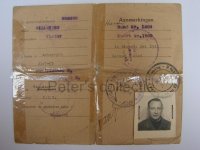 DSC06220.jpg157.4 KB · Views: 33
DSC06220.jpg157.4 KB · Views: 33 -
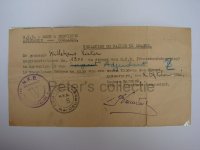 DSC06221.jpg121.6 KB · Views: 19
DSC06221.jpg121.6 KB · Views: 19 -
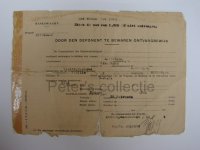 DSC06222.jpg137.7 KB · Views: 20
DSC06222.jpg137.7 KB · Views: 20 -
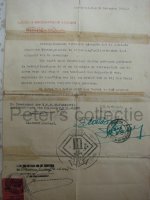 DSC06223.jpg104.7 KB · Views: 16
DSC06223.jpg104.7 KB · Views: 16 -
 DSC06224.jpg89.8 KB · Views: 18
DSC06224.jpg89.8 KB · Views: 18 -
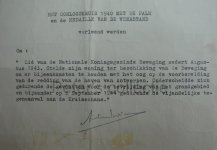 DSC06225.jpg129.3 KB · Views: 14
DSC06225.jpg129.3 KB · Views: 14 -
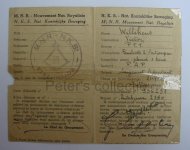 DSC06226.jpg212.6 KB · Views: 14
DSC06226.jpg212.6 KB · Views: 14 -
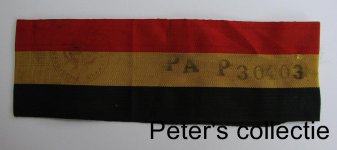 DSC06227.jpg132.3 KB · Views: 13
DSC06227.jpg132.3 KB · Views: 13 -
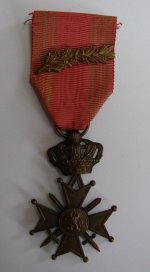 DSC06228.jpg71.1 KB · Views: 13
DSC06228.jpg71.1 KB · Views: 13





